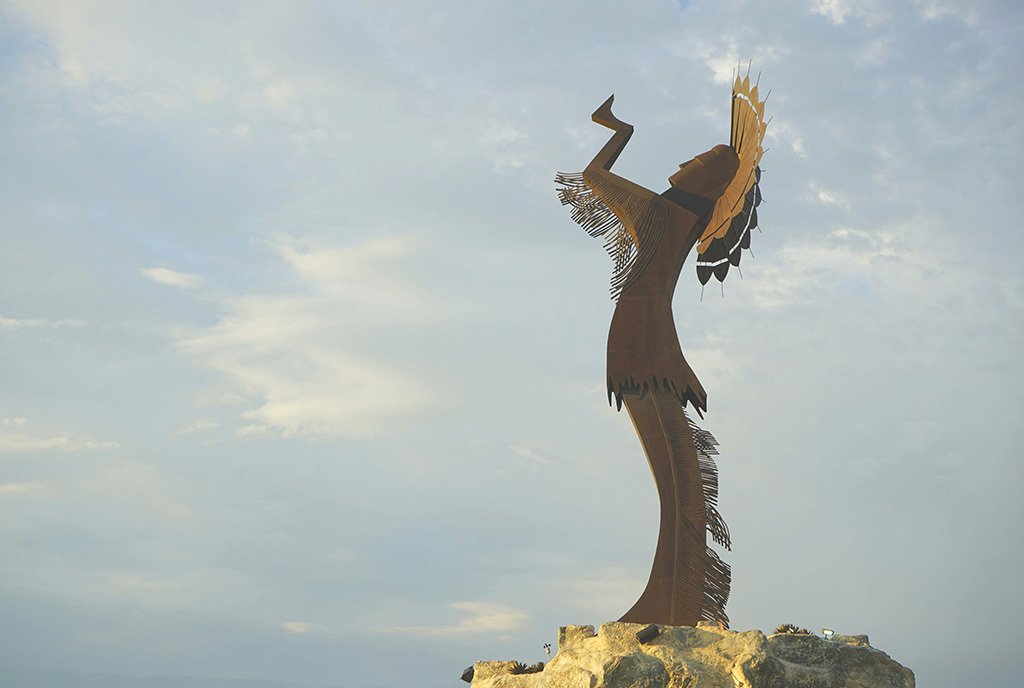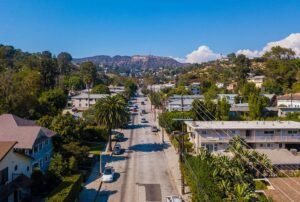
In April 2024, the US Environmental Protection Agency announced a $400 million grant to support renewable energy lending to a consortium of 63 lenders, led by the Native CDFI Network (NCN). As the National Law Review reports, the grant will support 58 Native community development financial institutions (CDFIs) and five other Native financial institutions.
The source of funding is the Clean Communities Investment Accelerator program, a $6 billion federal initiative created by 2022’s Inflation Reduction Act (climate bill) that aims to “establish hubs that provide funding and technical assistance to community lenders working in low-income and disadvantaged communities.” NCN’s proposal indicates that over six years, the grant will support $1 million per lender for technical assistance and $10 million per lender to finance renewable energy projects.
For NCN, internally, the grant means its staff is expected to increase from three to 11 people. Externally, the grant promises to greatly expand Native renewable energy lending from a quarter of the 63 participating lenders and their communities to all of them. More broadly, the grant is an indicator of a larger economic transformation underway in Indian Country. For example, the Native CDFI Network itself only dates from 2009, and its first full-time staff person was hired in 2015.
Even a few years ago, a federal grant of this magnitude for Native economic development would have been difficult to imagine. But NCN’s award is not an isolated event. Rather, it is one of many signs of growing Native economic and political power—increasingly anchored in visions of Indigenous economics.
The State of Native Economies
A report published in June 2023 by First Peoples Worldwide, Integrated Capital Investing, and the Croatan Institute—titled Indigenizing Catalytic Capital and authored by Kate Finn, Melanie Matteliano, Jennifer Astone, and David LeZaks—documented “the growth and emergence of Native enterprise is occurring in multiple segments including through Native sole proprietorships, Native-owned small businesses…and many forms of tribally owned enterprises” (11).
A separate report, released in August 2023, authored by Kevin Klingbeil, three colleagues from Big Water Consulting, and two Urban Institute researchers—and published by the CDFI Fund—similarly found that “in recent years, the range of community economic development activities has dramatically expanded in some Native communities, including development of large-scale retail and healthcare facilities and regional utility and broadband service providers” (9).
Part of the work of economy building involves the building of institutions.
But deep inequity persists. For example, a 2022 study published by the Minneapolis Federal Reserve drew on data from Four Bands Community Fund, a CDFI serving the Cheyenne River Sioux Tribe. The results—as Donn Feir, Elijah Moreno, and Lakota Vogel detail—“the median wealth, or net worth, in the Four Bands sample was roughly $5,524, while the median net worth of a Black household was $20,730 and the median net worth of a White household was $181,440.”
One driver of the gap: extremely low rates of Native homeownership, itself in large part a product of how traditional finance typically has failed to make home loans on 56 million acres of reservation land that is held in trust by the federal government. “The total value of residential housing accounts for only 17 percent of all the assets the Four Bands clients own,” the authors reported, compared to 32 percent for Black households and 37 percent for Latinx households.
And, as a 2021 Harvard study pointedly noted, over the past few decades, “federal policies of tribal self-determination through tribal self-government have proven to ‘work’ in the sense that they have spurred widespread economic rejuvenation….A number of tribes have now prospered to the point of drawing equal with and even surpassing the economic development of their non-Native counterparts. However, a far larger number of tribes are indeed raising the well-being of their citizens, but still find that the historic deficits created by decades of land loss, underfunding, and not being able to exercise their sovereignty are large and stubborn adversaries.”
Filling the Gaps
Part of the work of economy building involves the building of institutions. While Native Americans have occupied the land that is today the United States for thousands of years, many Native institutions are of rather recent origin. This is no accident but rather a product of colonialism. From 1953 to 1975, the official federal policy toward Native American people was known as “termination”—in which the stated goal of federal policy was to end Native sovereignty altogether. During this period, federal recognition of 108 Native nations was, in fact, withdrawn, and more than 200,000 Native Americans were relocated from reservations to cities.
Native economy building depends not just on moving more dollars to Native entrepreneurs, but rather on building economic self-sufficiency and sovereignty.
In 1975, in response to Native American organizing, especially through the American Indian Movement, Congress passed the Indian Self-Determination and Education Assistance Act, which began to restore tribal nation authority.
Sign up for our free newsletters
Subscribe to NPQ's newsletters to have our top stories delivered directly to your inbox.
By signing up, you agree to our privacy policy and terms of use, and to receive messages from NPQ and our partners.
Many current Native institutions emerged out of this activism. The first tribal college, for example, was formed in 1968. Today, there are 35 accredited institutions, with a total student enrollment of 22,000. Native CDFIs emerged a little later and have also grown rapidly. Lakota Funds, which the First Nations Development Institute calls the “first reservation-based peer lending fund,” dates from 1986. As of 2023, according to Klingbeil and his coauthors, there were 65 CDFIs (48). A report from Oweesta, a Native CDFI intermediary, surveyed 39 Native CDFIs and found that the median CDFI in its survey had $7.3 million in assets in 2022, with total assets of the 39 surveyed loan funds adding up to about $368.7 million. Oweesta also reported on three considerably larger Native CDFI banks, each with over $200 million in assets.
These gains are impressive, but given that banks with less than $10 billion in assets are considered these days by federal regulators to be “small,” it’s clear that a sizeable gap remains between community financing needs and lending capacity.
In their report, Finn and her colleagues call for various interventions to address this gap, including: 1) more consistent and transparent data collection to generate comparable data and make it easier for non-Native investors to commit capital; 2) further grant support to strengthen Native intermediaries; 3) a commitment by non-Native investors to self-education regarding Native communities; 4) a focus on “integrated capital” that combines grant and investment support—as is the case with the federal grant received by the Native CDFI Network; and 5) a commitment by non-Native investors to open up their investor networks to Native entrepreneurs.
Redefining the Economy
Of course, growth alone is not enough. As Finn and her coauthors acknowledge, Native economy building depends not just on moving more dollars to Native entrepreneurs, but rather on building economic self-sufficiency and sovereignty. As Vogel, who directs Four Bands Community Fund, has noted, nation building is “why we do what we do.”
“There’s a lot that Indian Country has to offer, rooted in long-term, future-generations thinking. I don’t think we can overstate that.”
The Indigenizing Catalytic Capital report also acknowledges that the notion of wealth for many Native Americans differs greatly from capitalist norms. In Native communities, the authors observe, wealth “means financial success plus social wellbeing, community health, continuity of cultural practices, environmental connection, and other cultural values.” Or, as Vanessa Roanhorse (Navajo), cofounder of Native Women Lead, has put it, “an unspoken sense of commonality and responsibility…is so integral to everything we do.” Roanhorse adds, “We need a cultural shift across the board.”
Leveraging the Federal Opportunity
Last December, at its annual conference, Native CDFI Network speakers were preparing for the possibility of funding—with discussion centering both on the EPA grant and other federal programs. At the time, the proposal had already been submitted, but the award was not announced until this April.
Not surprisingly, most of the conversation concerned the nitty-gritty of implementation. After all, federal grant reporting can be onerous. Also, federal grant programs often discourage creativity in implementation. Yet this did not stop conference participants from envisioning a future economy that is more sustainable and centers Indigenous values.
On a panel about “blending the generational wisdom of our past with the sustainable vision for our future,” Stacey McQuade-Eger, executive director of Affiliated Tribes of Northwest Indians Economic Development Corporation—a nonprofit representing 57 Native nation governments across Oregon, Idaho, Washington, Alaska, California, and Montana—called on Native communities to use the federal monies they receive to deepen “intertribal commerce and sustain scalable economies in Indian Country that also benefit the communities that are adjacent.” The goal, she added, was “to see our people in Indian Country thrive and perpetuate not only monetary wealth, but also to perpetuate our traditional lifeways and culture.”
Representative Sharice Davids (D-KS, Ho-Chunk) made a similar observation about the opportunity for transformation,” noting that “there’s innovative stuff happening in Indian Country that draws in elements of big-picture and long-term thinking that the mainstream in our country does not have enough of.”
Davids added, “There’s a lot that Indian Country has to offer, rooted in long-term, future-generations thinking. I don’t think we can overstate that. The work you do could truly help the whole of our country be better and exist better.”












